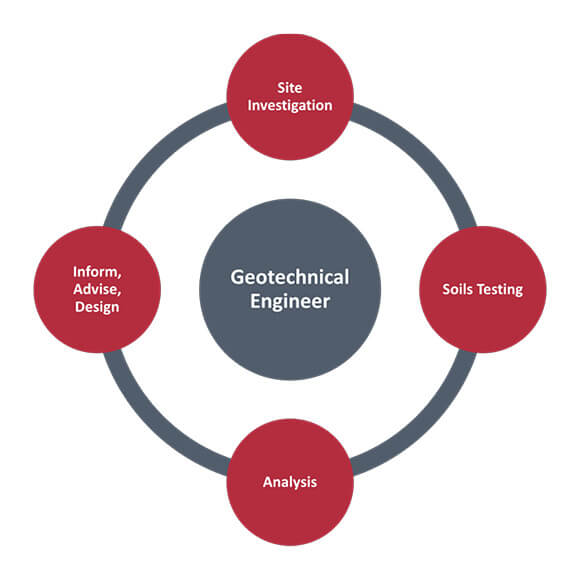All about Geotheta
All about Geotheta
Blog Article
Everything about Geotheta
Table of Contents6 Simple Techniques For GeothetaNot known Details About Geotheta The Single Strategy To Use For Geotheta4 Easy Facts About Geotheta Shown
They work together with civil designers, architectural engineers, designers, and various other experts to integrate geotechnical factors to consider right into the total job design and building procedure. This needs efficient synergy, control, and interaction to make sure that the geotechnical aspects align with the task goals and meet regulatory needs.Mining & Materials Design: Principles of exploration, penetration prices, and elements impacting the choice of exploration technique. Blowing up methods in surface area and below ground workings. Mechanical and continual approaches to fragmentation, consisting of longwall shearing and fullface boring.
Modelling of fragment and fragment size distributions; comminution as a transfer feature. Comminution modern technology: crushing, grinding, size category. Integrated analysis of fragmentation and comminution procedures. Supplied by: Mining & Materials Design.
Get This Report about Geotheta
Bachelor's degree programs in civil, geotechnical, geological, and environmental design generally last four years and consist of general education and learning courses in English, social science, and the liberal arts, as well as programs in innovative mathematics, structural geology, and fluid mineralogy. (https://my-store-fc66c1.creator-spring.com/)
Geotechnical engineering entails the evaluation of the dirt and rock problems at a particular website, and their effects for the development of that website. As many frameworks depend on the ground for support, it lacks shock that an in-depth understanding of the ground conditions, and the suitability of structure systems, are vital to the lasting stability and performance of the structure or framework.
Specialising in the examination of geological developments and ground behaviour, geotechnical engineers execute clinical examinations and testing to recognize the influence these geological developments may have on the style and building of structure, civil and framework tasks. This competence is critical for the layout and building and construction of buildings, roadways, tunnels, dams, bridges, and supply of water and sewer systems.
The geotechnical group at Douglas Allies regularly seek advice from with architects, design engineers, developers, and building contractors to make recommendations on design and growth propositions to ensure that the constructed frameworks are accordingly created for the ground problems. For instance, the layout of footing systems requires to consider the weight of the structure, the ability of the ground to sustain that weight with each other with activity tolerances and efficient building.
The Of Geotheta
This task is greatly streamlined by the use our Douglas Map geospatial platform that makes this information conveniently easily accessible in a simple to make use of web internet browser interface. A geotechnical designer will route the boring of boreholes and examination pits to accumulate soil and various other samples, and additionally assess surface area features and ground direct exposures to form a geotechnical design of the subsurface problems.
Depending upon the task type and ground problems encountered, research laboratory testing might amongst other points assess stamina, compressibility, reactivity and/or leaks in the structure of dirt and rock examples. After this data is accumulated and collected, the outcomes are used for a geotechnical version of the website, which is usually offered as areas throughout the site.

A geotechnical examination by nature can only examine the ground problems at the locations drilled or excavated. All-natural variants in soil and rock conditions can occur across a site and in between examination locations. It is for that reason excellent practice that the geotechnical engineer be kept throughout building and construction of the project to offer on-site verification that the ground problems run into follow the expectations and recommendations given in the geotechnical examination report.
Little Known Facts About Geotheta.
Geotechnical engineers utilize their comprehensive expertise of dirt and rock to examine danger and resolve issues on diverse framework projectsGeotechnical design is a specialist branch of civil engineering which looks at the behaviour of planet products and the application of soil and rock mechanics. Geo Tech Engineering. As a geotechnical engineer, you will examine the physical, mechanical and chemical buildings of soil and rock in order to design foundations, preserving structures and earthworks
Geotechnical design is closely connected to and overlaps with, both design geology and ground websites engineering - http://prsync.com/geotheta/. It's feasible to specialise in geotechnics or work for a geotechnical firm yet be recognized as a design geologist or a ground engineer. As a geotechnical engineer, you'll require to: develop and preserve connections with customers and various other professionals associated with the site, throughout each projectmaintain safety criteria on website bear in mind expense ramifications when you make recommendationsstudy geological maps and airborne pictures from a range of resources and from different time periodsexamine building plans to see exactly how viable they are based upon your understanding of the siteinvestigate risks or geological risks for the sitesearch for environmentally delicate attributes, such as garbage dump beginning to develop valid and expository ground modelsplan area investigationsdrill and analyse examples of bedrock, dirt, groundwater and extra products monitor other professionals on sitesolve technical concerns as they occur, such as unexpected frameworks at drill sitesmonitor conditions throughout and after building and construction to ensure structures are secure in the brief and long termadding information gathered on website to your preliminary researchcreating geotechnical calculations, drawings, and 2 or three-dimensional computer system designs translating the datamaking recommendations regarding the recommended use of the site

Report this page